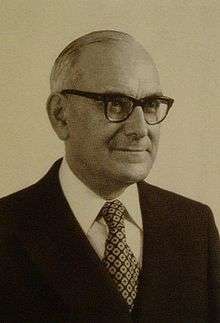Corporative Chamber

The Corporative Chamber (Portuguese: Câmara Corporativa) was one of the two parliamentary chambers established under the Portuguese Constitution of 1933, the other being the National Assembly. Unlike the directly elected National Assembly, it had a purely consultative, rather than legislative role.
The creation of the Corporative Chamber was part of corporatist philosophy advocated by Salazar and adopted by the Estado Novo. Its function was to represent the various economic, cultural, social, and other corporations.
The Corporative Chamber met in the former Senate chamber of the São Bento Palace. It was composed of members elected by the various types of Portuguese corporations, including:
- Provinces and Municipalities;
- Universities and Schools;
- Trade Unions;
- Economic Organizations and Employers;
- Social Welfare Organizations.
Presidents
The presidents of the Corporative Chamber were the following from 1935 to 1974:[1]
| Term | No. | Portrait | Name (Birth–Death) |
Term of office | Party | |
|---|---|---|---|---|---|---|
| Took office | Left office | |||||
| I | 1 |  | Eduardo Augusto Marques (1867–1944) |
10 January 1935 | 10 June 1944 | National Union |
| II | ||||||
| III | ||||||
| 2 |  | Domingos Fezas Vital (1888–1953) |
25 November 1944 | 25 November 1946 | National Union | |
| IV | ||||||
| 3 |  | José Gabriel Pinto Coelho (1886–1978) |
25 November 1946 | 25 November 1949 | National Union | |
| V | 4 |  | Marcelo Caetano (1906–1980) | 25 November 1949 | 8 July 1955 | National Union |
| VI | ||||||
| 5 |  | João Pinto da Costa Leite (1905–1975) |
28 November 1955 | 28 November 1957 | National Union | |
| VII | 6 |  | Luís Supico Pinto (1909–1990) |
28 November 1957 | 16 November 1973 | National Union (renamed People's National Action in 1970) |
| VIII | ||||||
| IX | ||||||
| X | ||||||
| XI | 7 |  | Mário Júlio de Almeida Costa (born 1927) |
16 November 1973 | 25 April 1974 | People's National Action |
See also
External links
References and footnotes
- ↑ "Estado Novo - Presidentes da Assembleia Nacional e da Câmara Corporativa". Assembleia da República. Archived from the original (PDF) on 28 April 2018. Retrieved 28 April 2018.